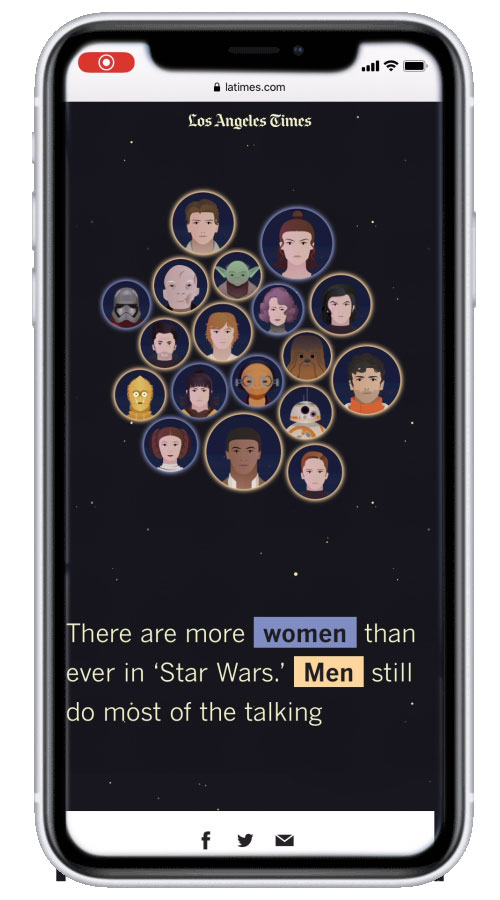There are more women than ever in ‘Star Wars.’ Men still do most of the talking



Star Wars: The Rise of Skywalker was going to end the latest trilogy in the popular “Star Wars” series. It was important for the Times to do what we could to cover the even before the release of the film.
We went through brainstorming sessions to figure out what we wanted to explore on the page. Ultimately, we settled on comparing Rey, the first female protagonist in the series, to other leads.
To make a reasonable comparison, we decided to explore how script writers handled Rey. We did this by counting words characters spoke, how and what they told each other, and more.

Daisy Ridley performs as Rey in “Star Wars: Rise of Skywalker” (Lucasfilm/Disney/Sky)
In 2019, Star Wars was set to release their latest film that would end the trilogy which started with Star Wars: The Force Awakens. As the first female protagonist in the series, we decided to look at how scriptwriters have handled her trilogy as compared to the men.
The basic flow of this project was first creating a purpose for our information - why exactly were we creating data based on words spoken? Is it fair to use this as a measure for Rey's worth in the trilogy? Afterall, there are different variables that can affect how much a character speaks. To explain this, a good structure to the peace was imperative - starting from a wider view of the star wars universe in general, to just the women, and finally, to Rey herself. Our staff writer, Tracy Brown was able to smoothly write this story in a way that made everything come together seamlessly.
We wanted to show how Rey compares to Luke and Anakin as the first female protagonist during a time when the #metoo movement was at the forefront of everyone’s minds.
To do this, we were tasked with using the character’s dialougues with others as a point of comparison.

Boards made in Adobe XD show initial mid-fidelity mock-ups (Swetha Kannan / Los Angeles Times)

We spent hours figuring out which characters spoke the most and thus needed to be included on the page (Swetha Kannan / Los Angeles Times)
The basic flow of this project was first creating a purpose for our information - why exactly were we creating data based on words spoken? Is it fair to use this as a measure for Rey's worth in the trilogy? Afterall, there are different variables that can affect how much a character speaks. To explain this, a good structure to the peace was imperative - starting from a wider view of the star wars universe in general, to just the women, and finally, to Rey herself. Our staff writer, Tracy Brown was able to smoothly write this story in a way that made everything come together seamlessly.
Reporting this project was a monumental team effort. I worked on a 3-person team and we each took a turn re-watching all 8 movies of the Star Wars films. As we watched, we fact-checked the scripts we had for each movie, counted each beep and boop R2D2 and other robots made and counted all of Chewie's groans. As we worked we faced important questions that required serious decision-making: When do we count Anakin's lines as his own and when do we count it as Darth Vader? Should Padme's lines be attributed to her even if it is Sabe, dressed as the queen, actually speaking?
We needed a good way to represent each character in our design (because a huge visualiation we intended to create was a relationship graph which showed almost 50+ characters) and thus decided to draw them ourselves. We went through a series of mid-fidelity design mock-ups before we landed on what was eventually published.
The data needed to be presented in easy to understand ways that also guided readers through a story.
The page needed to perform well on all platforms, since over 40% of the Times' audience at the time used mobile devices to access the site.
In order to talk about a variety of characters, we needed visuals that represented everyone.

The story published on December 19, 2019.
The story was a hit with our readers although It was definitely divisive with fans who either liked or disliked it. Funnily enough, our data was able to accurately predict the total amount of words Rey would come to speak in the final movie of her trilogy - and no, she was not able to catch up to her two predecessors.
If you want to see the data yourself, what we gathered is now public on github.
The story won a variety of awards in the coming year after it’s release
2019 Award of Excellence at Society of News Design(SND) awards
2020 National Arts and Entertainment Journalism, Award for Graphics
2020 National Arts and Entertainment Journalism, Award for Commentary Analysis/Trend in Film
2020 National Arts and Entertainment Journalism, Award for Commentary Diversity/Gender